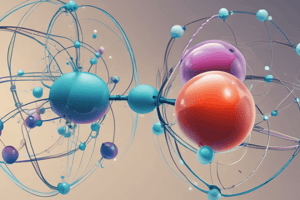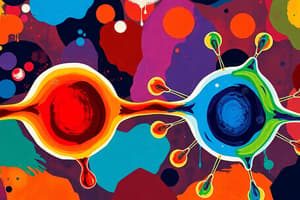Podcast
Questions and Answers
Which type of interaction is dominant when a drug first enters a binding site?
Which type of interaction is dominant when a drug first enters a binding site?
- Covalent bonds
- Hydrophobic interactions
- Van der Waals forces
- Ionic interactions (correct)
What is true about ion-dipole interactions when compared to dipole-dipole interactions?
What is true about ion-dipole interactions when compared to dipole-dipole interactions?
- Ion-dipole interactions are typically stronger than dipole-dipole interactions. (correct)
- Ion-dipole interactions are weaker than dipole-dipole interactions.
- Both types of interactions are identical in strength.
- Dipole-dipole interactions can occur without opposite charges.
In a hydrophobic environment, how does the strength of ionic interactions change?
In a hydrophobic environment, how does the strength of ionic interactions change?
- Strength fluctuates randomly.
- Strength decreases significantly.
- Strength remains unchanged.
- Strength increases. (correct)
Which statement accurately describes dipole interactions?
Which statement accurately describes dipole interactions?
What primarily influences the strength of ionic interactions?
What primarily influences the strength of ionic interactions?
How do drug molecules typically interact with receptors to form stable complexes?
How do drug molecules typically interact with receptors to form stable complexes?
What differentiates reversible inhibitors from irreversible inhibitors in enzyme inhibition?
What differentiates reversible inhibitors from irreversible inhibitors in enzyme inhibition?
What type of bonds contribute most significantly to the specificity and affinity of drug-receptor interactions?
What type of bonds contribute most significantly to the specificity and affinity of drug-receptor interactions?
Which type of interaction is characterized by a charge interacting with the dipole moment of another molecule?
Which type of interaction is characterized by a charge interacting with the dipole moment of another molecule?
What distinguishes hydrogen bonding from other dipole-dipole interactions?
What distinguishes hydrogen bonding from other dipole-dipole interactions?
Which statement correctly describes the strength of ion-dipole interactions compared to dipole-dipole interactions?
Which statement correctly describes the strength of ion-dipole interactions compared to dipole-dipole interactions?
For which pharmacological application could hydrogen bonding be particularly relevant?
For which pharmacological application could hydrogen bonding be particularly relevant?
How does the strength of dipole-dipole interactions compare to hydrogen bonds?
How does the strength of dipole-dipole interactions compare to hydrogen bonds?
What is a key feature of ion-dipole interactions that enhances their binding capability in drug-receptor interactions?
What is a key feature of ion-dipole interactions that enhances their binding capability in drug-receptor interactions?
What is the primary difference between reversible and irreversible inhibitors in terms of binding interactions?
What is the primary difference between reversible and irreversible inhibitors in terms of binding interactions?
What type of intermolecular binding would likely be most relevant in designing an insomnia drug such as Zalepan?
What type of intermolecular binding would likely be most relevant in designing an insomnia drug such as Zalepan?
How do intramolecular hydrogen bonds potentially affect the pharmacological activity of a drug?
How do intramolecular hydrogen bonds potentially affect the pharmacological activity of a drug?
Which functional group has the highest potential for hydrogen bonding in medicinal chemistry?
Which functional group has the highest potential for hydrogen bonding in medicinal chemistry?
What is the significance of van der Waals interactions in drug-receptor binding?
What is the significance of van der Waals interactions in drug-receptor binding?
Which type of intermolecular binding would most likely stabilize the secondary structure of proteins?
Which type of intermolecular binding would most likely stabilize the secondary structure of proteins?
Which statement is true regarding the role of hydrogen bonds in peptides and proteins?
Which statement is true regarding the role of hydrogen bonds in peptides and proteins?
In terms of enzyme inhibition, which type of inhibitor consistently binds to the active site and prevents substrate interaction?
In terms of enzyme inhibition, which type of inhibitor consistently binds to the active site and prevents substrate interaction?
What characterizes irreversible inhibitors in enzyme activity?
What characterizes irreversible inhibitors in enzyme activity?
Which of the following statements about hydrophobic interactions is correct?
Which of the following statements about hydrophobic interactions is correct?
Flashcards are hidden until you start studying
Study Notes
Non-Covalent Bonding
- Weak interactions that are reversible.
- Four types are essential in drug bonding interactions: ionic interactions, dipole interactions, hydrogen bonding, and Van der Waals interactions.
Ionic Interactions
- Strength of the ionic interaction is inversely proportional to the distance between charged groups.
- Stronger interactions occur in hydrophobic environments.
- Ionic bonds are the most important initial interactions as a drug enters the binding site.
- Example: Advil (Ibuprofen)
Dipole Interactions
- Occur when the greater electronegativity of atoms like oxygen, nitrogen, sulfur, and halogens relative to carbon creates an asymmetric distribution of electrons; this results in electronic dipoles.
- These dipoles in a drug molecule can be attracted by ions (ion-dipole interaction) or other dipoles (dipole-dipole interaction) in the receptor if charges of opposite signs are properly aligned.
- Dipole-dipole interactions are weaker than ion-dipole interactions because the charge of a dipole is less than that of an ion.
Ion-dipole interactions
- Occur where the charge on one molecule interacts with the dipole moment of another.
- Stronger than a dipole-dipole interaction.
- Strength of interaction falls off less rapidly with distance than for a dipole-dipole interaction.
Dipole-dipole Interactions
- Occur between two dipoles, where the partial positive charge of one dipole is attracted to the partial negative charge of the other dipole.
Hydrogen Bonding
- A type of dipole-dipole interaction formed between exchangeable protons.
- Formed between the proton of a group X-H, where X is an electronegative atom, and other electronegative atoms (Y) containing a pair of nonbonded electrons.
- Represented as a dotted line: -X-H…..Y-, indicating that a covalent bond between X and H still exists but an interaction between H and Y also occurs.
- Play an essential role in maintaining the structural integrity of the secondary structure (α-helix and β-sheet conformation of peptides and proteins and double helix of DNA).
Van der Waals Interactions
- Very weak interactions.
- Occur between hydrophobic regions of the drug and the target.
- Transient areas of high and low electron densities cause temporary dipoles.
- Interactions drop off rapidly with distance.
- Overall contribution of van der Waals interactions can be crucial to binding.
Studying That Suits You
Use AI to generate personalized quizzes and flashcards to suit your learning preferences.




